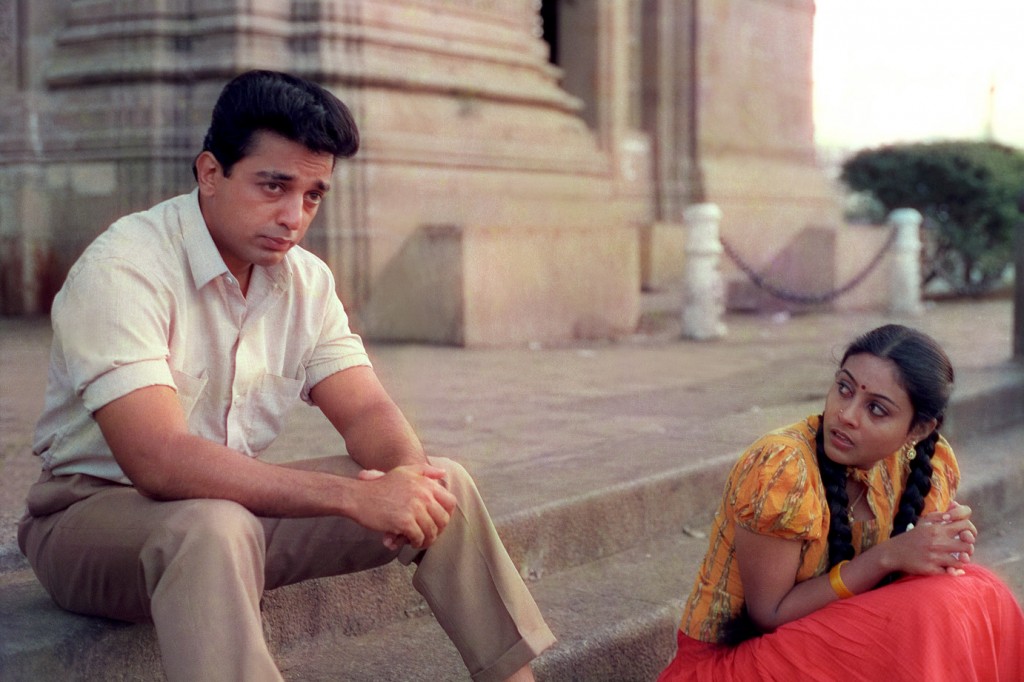A political activisit is killed by the police. His son attacks the cop and runs away to Bombay. In Bombay, he grows up as Velu Naicker (Kamal Haasan) operating from a ghetto. When he kills a much hated police officer in a fight, he instantly becomes a hero in the eyes of the slum dwellers. Naicker soon becomes a ganglord, engaging in smuggling while protecting the down-trodden. On one of his visits to the brothel, he comes across a beautiful timid young girl (Saranya) and marries her. When a builder buys the land on which the slums are situated, Naicker attacks his house and destroys the title deed making him even more of a hero in the eyes of the people. As he gets bigger and bigger, he starts eliminating rival gangs. He becomes so big that even police officers and the like come to him for help. His lifestyle, however, catches up with him on the personal front. His wife is killed by a rival gang and his daughter walks out on him after knowing the truth about him and marries a police officer bent on catching him. His son dies in an accident. Even as he is acquitted by the court, the mentally deranged youth, the son of the police officer he had killed, shoots him dead.
Nayakan is undoubtedly one of the finest Indian films and certainly till date remains Mani Ratnam’s most accomplished work . The film is loosely based on the life of the Bombay based ganglord Varadarajan but Ratnam infuses his tale with a Godfather like feel, making for a rivetting cinematic experience.
The film’s treatment might be ‘inspired’ from The Godfather (1972) and The Godfather II (1974), but Nayakan is a great film that stands firmly on its own merits, beautifully combining elements of mainstream Indian cinema with an extremely strong sense of cinematic narration. While the film’s content is standard in may ways with a none too fresh look at crime, power and the underworld, the film’s flow is most effectively and innovatively constructed scene by scene showing us a talented filmmaker at the peak of his prowess, knowing how to tell a story on celluloid.
The story moves ahead crisply and assuredly and the film’s screenplay is full of several sequences that remain with you and haunt you long, long after the film is over. Sequences that are as varied as the extremely heart-warming one of Velu’s son imitating him in front of his friends to the heart-renderingly poignant one of Velu breaking down and letting out a cry of anguish at his son’s death; his first meeting with his wife-to-be in a brothel to his confrontation with his daughter; But undoubtedly, the film’s most memorable moment comes when Velu Naicker is asked by his grandson even as he is being led to court for trial for his crimes if he is a good man and he replies, “I don’t know…”
Though the life of the don could easily have been shown in a typical-larger-than-life manner as was prevalent in mainstream Indian cinema then, Nayakan like Deewaar (1975), differs in its treatment, beautifully humanizing the gangster and showing him to be down to earth and normal with his share of good points as well as his flaws. This helps to create a memorable multi-layered flesh and blood character with whom the viewer is able to sympathize. That he is brought to life by Kamal Haasan helps tremendously.
In fact, Kamal Haasan as Velu Naicker is the life and soul of Nayakan. The film is simply unimaginable without him and he shows us in Nayakan why he is rated as one of the finest actors ever in India. His performance ranks as one of the greatest ever in the history of Indian cinema as he expertly captures every nuance, every shade of Velu Naicker, be it the ruthless don, the benevelant protector of the opressed or the loving and caring family man. He touches you and moves you with his impeccable act deservedly winning the National Award for Best Actor. The rest of the cast support him perfectly realizing it is Kamal’s film but leaving their own mark on the film be it Saranya or Janakaraj or Nizhalgal Ravi as Naicker’s son.
Technically too, the film is a most accomplished piece of work. Special mention has to be made of Thotta Tharani’s brilliant art direction and PC Sreeram’s absolutely stunning cinematography. The entire Dharavi slum in Bombay was painstakingly and realistically created in a studio in Madras and looks more authentic than the real thing with much attention paid to every minute detail. Sriram’s framing with some extremely good use of the foreground and background, his skilfull use of source lighting and his wonderful play of light and shade is just masterly (See the sequence where Kamal Haasan meets Saranya for the first time). Both, Tharani and Sreeram, deservedly won National Awards for their fine work in the film. Ilayaraja’s music, in particular the songs Thenpandi Seemaiyile and Nilaa Adhu and his rousing background score are as usual a big, big asset to the film. The songs are beautifully choreographed and picturised, the editing is crisp and mention must also be made of the evocative sound design in the film as well.
True, there are certain ‘commercial’ elements that do stick out like the sexy dance on the boat but these are minor flaws in an otherwise great film.
A much awarded film, the film was India’s official entry to the Oscars for Best Foreign Film and was included by Time magazine in its list of 100 all time greatest films in 2005. It was also the film that made Mani Ratnam a highly regarded filmmaker not just in Tamil Nadu but throughout India.
Tamil. Action, Drama, Color


